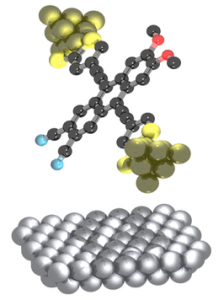Nanomechanics

Molecular mechanics
Nanoscale motors play an important role in biological processes and this has inspired chemists to make synthetic molecular motors, most of which are fuelled by the stochastic impulses from photons. We have proposed a single-molecule motor, integrated into a three-terminal device based on electric field actuation and electric current detection. In this all-electric motor, the motion of a dipolar moiety of a conjugated molecule, the `rotor’, is driven by the alternating gate field (An all-electric single-molecule motor, J.S. Seldenthuis, F. Prins, J.M. Thijssen and H.S.J. van der Zant, ACS Nano 4 (2010) 6681). Depending on the rotor position, the degree of conjugation in the molecule varies, so that the motion can be detected through read-out of the current through the molecule. The device can also be operated as a switch and, by varying the temperature and chemical structure, allows for probing the physics of this electromechanical system in the classical and in the quantum regime. First measurements involving molecules with dipole moments are underway.
Nanomechanics model systems
The mechanics on the nanoscale is characterized by its floppiness, meaning that small forces may yield large (relative) displacements and correspondingly interesting new nonlinear effects. Model systems for the study of these effects are suspended carbon nanotubes, suspended garphene membranes or silicon based resonators with large aspect ratio’s. Nowadays, the study of nanomechanics has become an important direction in the group involving Gary Steele, Warner Venstra and Peter Steeneken (part-time professor working at the company NXP).
Some highlights of previous years include: the detection of the bending vibration mode of a suspended carbon nanotube (Nano Lett. 6 (2006) 2904), the observation of strong coupling between mechanical motion and electron stransport (Science 325 (2009) 1103), measurement of the mechanical properties of suspended few-layer graphene (Appl. Phys. Lett. 92 (2008) 063111), measurement of the size-dependence of the Young modulus in silicon nitride cantilevers (Appl. Phys. Lett. 94 (2009) 233108), bit-operations in a silicon clamped-clamped resonator (Appl. Phys. Lett. 94 (2009) 183501) and in a silicon-based cantilever (Appl. Phys. Lett. 97 (2010) 193107), mode-coupling within clamped-clamped resonators (Phys. Rev. Lett. 105 (2010) 117205), Q-factor control in micro-cantilevers (Appl. Phys. Lett. 99 (2011) 151904) and the measurement of the elastic properties of MoS2 sheets (Adv. Mat. 24 (2012) 772).
